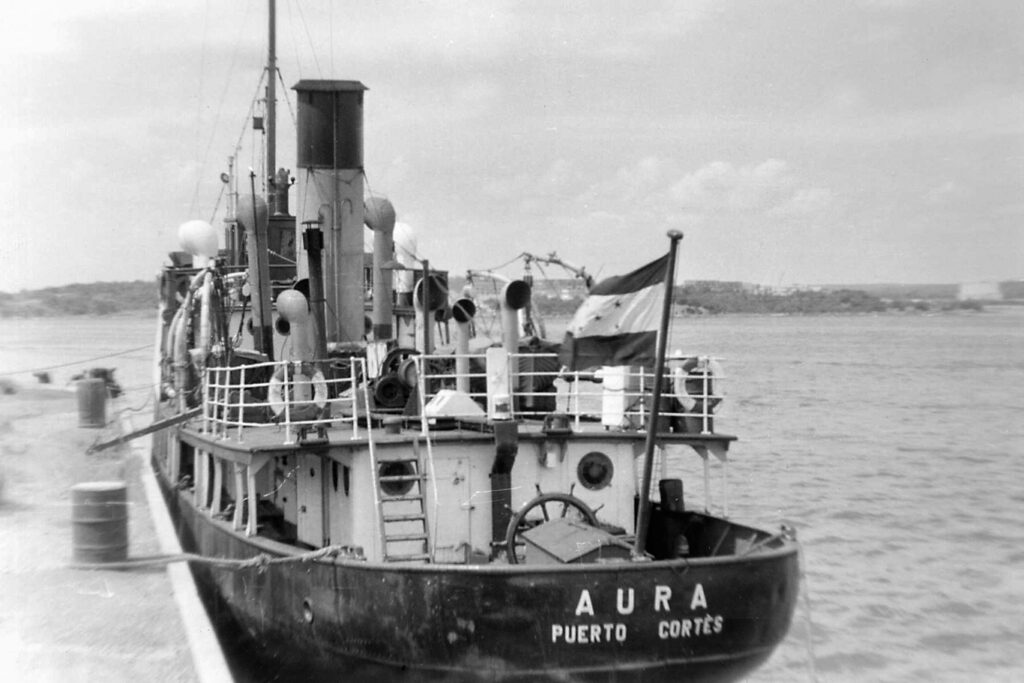Boats

The Aura sailed under the Honduran flag.
Aura
The Aura was a 434-ton cargo steamer. Its ownership is unclear–it either belonged to the Truberg brothers’ shipping company or to about 25 mostly Estonian refugees who had worked odd jobs in the British isles after the war and saved up to buy the boat.
The trawler was not one of the tiny “Viking boats” that slipped out of Sweden and crossed the Atlantic in the late 1940s, but newspapers used that moniker because the boat transported Baltic refugees illegally to North America.
In 1951, the Aura, enroute from England to New York, stopped in Ireland. Since the ship was short of manpower, the captain, L. Truberg, agreed to take on board Estonian refugees Viktor and
Agnes Palango as a machinist and stewardess, and Toivo, their 5-year-old son. The Palangos were living in Ireland following their escape from Sweden two years earlier on the Victory, an overcrowded, unseaworthy refugee ship that the Irish authorities barred from sailing further after it arrived in Cork in September 1949. By 1950, most of the Victory’s passengers had immigrated to Canada, and the Palangos wanted to leave as well.

Toivo, Agnes, and Victor Palango on board the Aura.
The Aura left Cobh, Ireland, on July 2, 1951, and arrived 12 days later in Halifax, Canada. In her memoir, Agnes Palango recalls that she was constantly seasick and found the work difficult. She began her day at 5 a.m. helping the cook prepare meals, set the table, and wash dishes three times a day.
When the Aura docked in Halifax, only a few of the Estonian passengers, who had proper visas, were allowed to enter Canada. The Palangos were not allowed to disembark because the captain, despite an agreement, had not registered them as crew and they had no official status. According to Mrs. Palango, Captain Truberg’s planned destination was New York, where he had lived before the war and reportedly owned an apartment building. He had taken on the passengers to help cover his transit costs.

“Viking ship awaits at the gates of New York” On September 8, 1951, Vaba Eesti Sõna reported on the Aura’s passengers’ problems trying to enter Canada and the United States without visas.
After two weeks the Aura continued to New York City, but it was not allowed to enter the harbor. After immigration authorities left the ship, however, Captain Truberg contacted a harbor boat, which the Palangos took to New York. They headed to the Manhattan home of Enn Kalde, their son’s godfather, who had arrived in America in 1948 on the Prolific.
The Palango family had reached America, but they did not have entry visas. A Hungarian lawyer who had helped other Estonian refugees recommended they stay out of sight until the Aura left port. Based on Enn Kalde’s suggestion, they took a Greyhound bus to Los Angeles and were able to rent a room at the city’s Estonian House. When the Palangos received word of the Aura’s departure, they visited an immigration office to announce their presence and obtained temporary residence permits.
Five years passed before the U.S. Congress passed a special law assisting war refugees who had fled from occupied countries.

Stockholms-Tidningen Eestlastele reported September 12, 1951, on the passengers’ problems trying to enter Canada and the United States without visas. The Aura was forced to leave Halifax before Estonian organizations in Canada were able to help the refugees.
Through that, the Palango family obtained permanent status, and life in their new homeland could officially begin. Mr. Palango, a 10-time track-and-field champion in Estonia from 1942 to 1944, had qualified to join the 1948 Swedish Olympic team but could not participate because he was not a Swedish citizen. In the United States, he joined Estonian sport teams and found a job in a furniture factory, eventually becoming its director. Agnes Palango worked in a bank and served as the bookkeeper for the local Estonian church. Both were active members of the Estonian community in Los Angeles for the rest of their lives.
When the Palangos fled Estonia for Sweden on September 21, 1944, they thought they would be gone for a couple of months. Almost 50 years passed before Viktor Palango returned to independent Estonia in 1993. After landing in Tallinn, he knelt and kissed the ground.
Known crew and passengers:
- Captain L. Truberg
- Harold Sepp
- Viktor and Agnes Palango and their son Toivo
Photographs reproduced with permission from the Estonian Maritime Museum.
